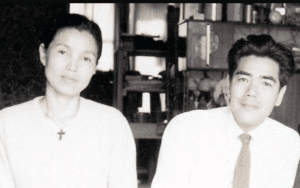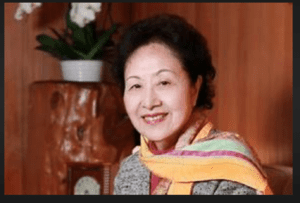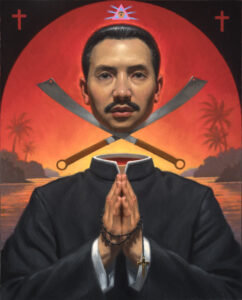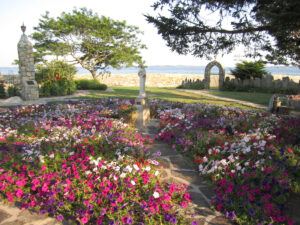Martin Scorsese’s 2016 film version of Silence drew renewed scrutiny to the famed Catholic Japanese novelist Shusaku Endo: Were Endo and Scorsese attempting to applaud apostasy?
More on that in a minute. But to me, what was missed in the ensuing brouhaha was a more important point: Endo is not the only Japanese Catholic novelist. In the 20th century a whole circle of Japanese Catholic writers flourished, few of whom are known outside of Japan in either literary or Catholic circles.
Yet some of these great artists are still living, and some can be yours, in translation.
If the Truth is universal, then surely Catholics mustn’t barricade ourselves exclusively in the corridors of Western literature. And there is no place better to test the universal Truth of the Catholic faith than Japan—a culture extraordinarily ancient, rich and yet also quite distinct from the West or Near East in which Christianity long flourished.
For Americans and other Westerners to journey into Catholic Japanese culture requires a nuanced sensitivity, and the kind of open mind that G.K. Chesterton called for—looking for substantive Truth in unlikely places.
So, let me say in Japanese, “irasshai”: Welcome to the adventure!
The Strange Case of Endo and Apostasy
Even before Martin Scorsese’s 2016 feature film Silence, Endo was widely known as the Graham Greene of Japan. And Endo’s reputation in America and Europe, for better or worse, has largely rested on that 1966 historical novel about the apostasy of a Jesuit missionary in early seventeenth century Japan.
Many faithful Christians accepted at face value the interpretation that Endo (and Scorcese) approved of the apostasy of Fr. Rodrigues. To me, this is a strange case of cultural misappropriation, driven largely by scholarship and circumstances in the West.
Chinmoku (“Silence,” in Japanese) was published in 1966, only one year after the closing of the Second Vatican Council. But at that time, Japan was not yet swept up in the tumult of liturgical and doctrinal dissent that spread across the Euro-American world. As Fr. Adolfo Nicolás, S.J. has noted, the impact of Vatican II was not really felt in Japan until the mid-1980s.
Yes, Silence was controversial in 1966 among some Japanese Catholics, mainly among old Catholic families who felt that Endo was not respectful enough of the sacrifices their ancestors had made. But for Japanese readers, Rodrigues’ apostasy was not a recommendation, it was simply a fact of Japanese history.
Here, timing is everything. William Johnston’s English translation of Silence appeared in 1969, just one year after the annus horribilis that saw wide-spread dissent among Catholic theologians over Humanae Vitae.
Ever since, the Anglosphere’s literary applause for Silence has been tied to a positive view of Rodrigues’s apostasy. The Euro-American explosion of Endo studies and translations was led primarily by mainline Protestants who have been joined by a few Catholics of a more liberal bent including: The Sea and Poison, Gallagher, 1972; Wonderful Fool, Mathy, 1974 Volcano, Schuchert, 1978; Samurai, Gessel, 1982; Scandal, Gessel, 1988; Foreign Studies, Williams, 1989; The Girl I Left Behind, Williams, 1994; Kiku’s Prayer, Gessel, 2013.
In short, the interpretive tradition that sees Endo as leading a dissenting movement in Catholicism took on a history that was quite independent of how Endo’s primary audience of Japanese readers interacted with his work.
Nothing highlights this fact more clearly than the reality that whereas in the West it is Silence that defines Endo’s reputation, Japanese readers have preferred Endo’s 1980 historical novel Samurai.
Silence can of course be read in a manner consistent with orthodoxy, as the Catholic Japanese scholar Michihiro Yamane has demonstrated. Indeed, even in Scorsese’s film version, a cock crows three times at the very moment Father Rodriques betrays Christ, a subtle gesture to orthodoxy many Catholic critics in America failed to notice. The betrayal of Christ began with Peter, the film version seemed to say. And it has been repeated many times in history in many if not most our fallen human hearts.
What was Endo’s response to the Japanese criticism of Silence? In 1973, he chose to publish two overtly religious works: A Life of Jesus and Beside the Dead Sea. These were followed in 1978 by The Birth of Christ. The decision to write these kinds of works are not the actions of an ambivalent Christian in Japan.
Samurai, Endo’s first post-Silence novel published in 1980, also begs to be read as a response to the Japanese Catholic criticisms of Silence. Samurai, like Silence, is set in early 17th century Japan, based on the real-life incident involving Blessed Luis Sotelo, O.F.M (1574-1624) and a Japanese samurai, Philip Francis Hasekura (1571-1622).
Together these two Catholics in 1613 on a set out mission from Japan that took them all the way to Rome where they met Pope Paul V.
I do not want to spoil the novel for anyone who hasn’t read it yet. But suffice it to say that reading Silence in light of Samurai, it is entirely plausible to interpret Silence as a tragedy that prepared the way for the comedy of Samurai. Those who have grown pessimistic about Endo after reading Silence should read Samurai.
But keep in mind that the meaning of the word “samurai” is not limited to a swashbuckling warrior. Its root meaning comes from the verb samurau (to serve). A samurai is a servant, and the question Endo asks in this novel is: “Who is the real Servant (of God)?”
Beyond Endo: The Other Japanese Catholic Literary Renaissance
But for all the attention Endo has received in the West, the most important thing to notice about Endo has been largely overlooked: He was not alone. He was part of a 20th century flourishing of Catholic and Christian Japanese writers. Who are some of the best-known Catholic Japanese literary heroes who vie for attention with Endo among Japanese readers?
Consider one of the earliest: the poet and author of children’s literature Rofu Miki (born Masao Miki, 1889-1964). Rofu Miki is probably best known in Japan as the lyricist of the famous Japanese children’s song “Akatonbo” (Red Dragonfly) whose words were set to music by Kosaka Yamada in 1927. (You can hear it here.)

Miki was baptized in 1922 while teaching literature in a Trappist monastery in Hokkaido. In 1927, Pope Piux XI made Rofu Miki a Knight of the Order of the Holy Sepulchre of Jerusalem. Struck by a taxi in 1964, he died of brain hemorrhage eight days later.
Rofu Miki was a prodigious author. His non-fiction writings include a history of Catholicism in Japan (Nihon Katorikku kyōshi, 1929). His best-known poems include “Abandoned Garden” (haien, 1909) and “God and Man” (kami to hito, 1926).
Some of his poems have been translated and included in Ninomiya Takamichi and D J Enright, The Poetry of Living Japan (Grove Press, 1957); Kenkichi Yamamoto, William Elliott, Katsumasa Nishihara, The Singing Heart (Katydid Books, U. Hawaii Press, 2001) and Eunice Tietjens, Body and Raiment (AA Knopf, 1919).
Here is one from The Poetry of Living Japan (which is now available free on the internet) available in English translation. “Bells Across the Snow” gives a taste of Miki’s Japanese symbolist poetry:
‘Bells across the snow’ was a rather well-used Victorian Christian trope by the time Rofu Miki penned this poem. “Bells across the snow” for example, was a phrase used by Alfred Lord Tennyson in his poem “Ring Out Wild Bells,” part of his most famous book In Memoriam. The phrase was also used as the title of a well-known Protestant Christmas Hymn by Frances Ridley Havergal. [1]
Rofu Miki is an early representative of the vigorous Catholic intellectual world in prewar Japan.[2] But after World War II, Japanese Catholic conversions among novelists really bloomed.
Take the famous Catholic Japanese writer-couple, Chikao Tanaka (1905-1995) and his wife Sumie Tanaka (nee Tsujimura, 1908-2000). A native of Nagasaki, Chikao Tanaka was writing as early as the 1930s, but he was not baptized until late in life, in 1988. In 1934, however, he married Sumie who was an instructor at the Catholic Sacred Heart Women’s Academy. In 1951 Sumie was baptized in the Catholic Church, along with her children. Soon after Catholic themes emerged in Chikao Tanaka’s plays.
Two plays by Chikao Tanaka are available in English: “Education” (1954) in the Columbia Anthology of Modern Japanese Drama (2014) and “The Head of Mary: A Nagasaki Fantasia” in David G. Goodman’s After Apocalypse (1994).
“The Head of Mary” made Chikao Tanaka’s reputation as a Catholic playwright. Set in the immediate post-nuclear bomb years in his hometown of Nagasaki, the story follows a motley crew of prostitutes, gangsters and assorted underclass as they recover the bomb-damaged statue of Mary from the ruins of the Urakami Cathedral. In the process, there is a miraculous moment of redemption that will touch the hearts of all who read it.
Sumie Tanaka was arguably an even better playwright than her husband, and also a first-rate screenwriter. Among her many works is “Adulteress: The Drum of Waves” (Tsuzumi no onna; 1955). While the work has not been translated into English, Taeko Tomioka has written a good overview of it, emphasizing that it treats the issue of adultery from a Christian moral perspective (in Chieko Irie Mulhern, ed., Japanese Women Writers: A Bio-critical Sourcebook, 1994). Sumie Tanaka also is known for her “The Life of Gracia Hosokawa“(1956), the tragic story about the Catholic convert who lived from 1563-1600.
But perhaps the greatest of all Catholic Japanese novelists is Toshio Shimao (1917-1986). With Shimao, fact and fiction blend together in a particularly disturbing way. His theme is nothing less than an arresting, personal record of the human and spiritual costs of sin.

His most famous short story, The Sting of Death (1977), closely follows the true story of his own adultery, his wife’s consequent admission to a psychiatric ward, his self-admission to the same ward (“if she is sick, so am I, as we are one”), and their eventual recovery and release. Toshio Shimao called this story “a prayer to my wife.”
The Sting of Death begins: “On the following day, I noticed that the alarm clock on my desk, which had stopped long ago was running again…In the past it had not responded even to vigorous shaking. But there it was now, ticking away diligently. My first thought was that my wife’s will had lodged itself within.” What follows is a rich and closely textured analysis of the breakdown and recovery of marital union.
The 1990 Japanese movie based on The Sting of Death, directed by Kohei Oguri, won a number of prizes including the International Federation of Film Critics Prize and the Grand Prize of the Jury at the 1990 Cannes Film Festival.
Fortunately, the work is available for free on the internet as The Sting of Death and Other Stories, translated by Kathryn Sparling, University of Michigan Center for Japanese Studies, 1985).
Following his wife’s mental breakdown, Toshio Shimao gave up his promising career as a writer and moved from Tokyo to his wife’s hometown in the remote islands of the Ryukyu archipelago. There he converted to the Catholic faith of his wife’s family, receiving baptism in 1956. His wife later followed him back to the practice of her childhood Catholic faith.
The best-known living Catholic novelist in Japan is Ayako Sono (b. 1931). Educated at Sacred Heart Academy, she was baptized in 1948 as a teenager, and six years later published her first work, a short story called “Guests from Afar” about the US Occupation forces in Japan. She has not stopped writing since. Three of her novels are available in English: Watcher from the Shore (1990), No Reason for Murder (2003) and Miracles (2016).

Watcher from the Shore is a nuanced portrayal of the life of a gynecologist, Dr. Nobeji Sadaharu, his Catholic friend Yoko Kakei and her friend the Catholic priest Fr. Munechika. Dr. Sadaharu has no particular moral principles, yet his work draws him into moral discussions with Yoko and Fr. Munechika.
Ayako Sono does a brilliant job of showing the subtle, almost imperceptible effects of Dr. Sadaharu’s moral apathy on himself and on his relationship with his family.
No Reason for Murder, by contrast, is hardly a subtle novel—at least until the very end. Based on actual events, the story unfolds as an improbable platonic relationship between Fujio Uno, a serial rapist and murderer, and Yukiko Hata, a single, innocent if not-too-observant Catholic woman who tends to her gorgeous morning glories (the original Japanese title of the book is “Heavenly Blue,” after a variety of morning glories).
In between his crimes, Fujio drops by Yukiko’s house to chat. Yukiko accepts his overtures and tries to help him accept himself, all the while ignorant of his other side.
The real drama takes place after Fujio is arrested and sentenced to death. Yukiko faces the question of what it means have befriended a “moral monster” in Japan:
“Different from Fujio, somehow I feel that I do know something of the fullness of human life. The people who are taken to Mother Teresa’s “House of Those Awaiting Death,’ people living properly for just one day before their end, might taste a deep satisfaction before they die,” she muses.
I won’t spoil the ending. Suffice it to say, Sono is asking whether anyone, no matter how wicked, can be redeemed—and whether those who seem to be innocent may in fact be worse than the wicked.
Described as “a minor classic” by the Japanese literary scholar Philip Gabriel, Miracles is a loosely autobiographical work that follows Sono’s travels in Poland and Italy in pursuit of the miracles attributed to St. Maximillian Kolbe. (Ayako Sono attended Kolbe’s beatification in Rome in 1971.) More than an autobiography, the novel is a deep reflection on evil as well as on the possibility of miracles, both in the past and in the present.
Other famous novelists known in Japan for being Catholic writers include Kunio Ogawa (1927-2008) and Otohiko Kaga (1929-). Ogawa received baptism in 1947 as a young man of twenty years old. After traveling around the Mediterranean region from 1953 to 1956, much of the time on a motorcycle, he returned to Japan and wrote about his experiences, publishing them privately in his first work, Aporon no Shima (“The Isles of Apollon,”1957).
Kunio Ogawa’s first work impressed the great Japanese novelist Toshio Shimao who promoted it and gave Ogawa the opportunity to make a career in writing. This maiden work is characteristic of Ogawa’s favorite themes: Mediterranean cultures and Christianity. Ogawa self-consciously distanced himself from Endo, writing that “Mr. Endo is afflicted with the affliction of the modern Japanese intellectuals. His literary works take a bird’s-eye view of Christianity; he responds to Christianity historically and humanistically.” As Kazumi Yamagata has noted, Ogawa felt Endo’s tendency to foreground the differences between Eastern and Western cultures was “dangerous to literary creation.”[3]

Unfortunately, none of Ogawa’s work has been translated into English.
Otohiko Kaga has been translated into English. His 1982 historical fiction about World War II is available as Riding the East Wind: A Novel of War and Peace (2002), but many of his other important works (Winter in Flanders, 1967; The Verdict, 1979) have not been translated. Unfortunately, no-one has yet translated The Eternal City (1997) which was written after his 1987 baptism. His historical work on the Catholic feudal lord Blessed Ukon Justo Takayama has been translated into German as Kreuz und Schwert (2006). He is best known in Japan as a criminal psychologist and a leading activist against the death penalty.
Is There a Future for Catholic Japanese Novels?
This brief survey of Catholic novelists in contemporary Japan cannot cover them all. Names that make most lists of Catholic writers in Japan include Atsuko Suga (1929-1998), Toshio Moriuchi (b.1936), Tomie Ohara (1912-2000), Yusuke Fukuda (1931-2014), and Michiko Inukai (1921-2017) whose grandfather was prime minister of Japan and whose cousin (once removed) is the famous Catholic Sadako Ogata, former UN High Commissioner for Refugees. None of them have had their works translated into English.
One of the most famous novelists in postwar Japan who has been translated into English is Shotaro Yasuoka (1920-2013). Yasuoka was a long-time friend of Endo and was baptized in 1988 with Endō serving as his godfather. But none of his post-baptism novels have been translated, and it would be difficult to see any impact of Christian values in the English translation of his pre-baptismal novels. Satoko Kizaki (nee Masako Yokoyama; aka Masako Harada, b.1939) is a bit of a different story. Not nearly as well-known as Yasuoka, Kizaki was baptized in 1982, and two of her post-baptism works have been translated into English: The Sunken Temple (1993) and The Phoenix Tree and Other Stories (1990). But Catholic themes are not explicit in her novels, and in fact the Sunken Temple is about a Buddhist priest and his family.
Yuko Tsushima (b. Satoko Tsushima, 1947-2016) was the daughter of one of modern Japan’s most famous novelists, Osamu Dazai, although she never knew her famous father (He committed suicide when she was one years old.) She took the name Tsushima from her mother, Michiko Tsushima, also a novelist. Of Yuko Tsushima’s many novels, the two that have been translated into English and were written after her 1986 baptism are: Laughing Wolf (2001) and Of Dogs and Walls (2018). Her funeral Mass was held at St. Ignatius Church in Tokyo. Tsushima was a faithful Catholic for her last thirty years. But you would never know it from her novels or from the copious scholarship about her. She is probably the most famous Catholic writer who is least known for being Catholic.
Most of these Catholic novelists are now dead and of those who survive, most are quite old. But Catholicism is still vibrant in Japan. Most experts believe the official number of Catholics in Japan is seriously undercounted because of complex, cultural reasons. But even with the official (under)count, the number of Catholics in Japan today (509,000) is an increase over the number of Catholics in Japan in 1965 (316,131) when Japanese Catholic writers were at the zenith of influence.
Professor Masakazu Asami of the influential Keio University told me a few years ago that Christianity is a hot topic in the Japanese publication world. And indeed non-fiction works on Catholic history, theology, art etc. are all doing well in Japanese publications.
So where is the next generation of Catholic Japanese novelists?
I can only speculate. But it seems to me that Japanese fiction in general is suffering from a more universal tendency today in literature around the world to emphasize escapism, personal issues, identity, and sexual pleasures rather than the kind of serious moral issues that Catholic writers have tended to grapple with. There seems to be a sharper dichotomy between serious moral topics (often taken up in non-fiction writing in Japan today, including those with explicit Christian themes) and frivolous, escapist themes in fiction than there was in the post-War flourishing of Catholic Japanese fiction.
Visual arts such as anime do occasionally focus on Catholic themes. “Maria Watches Over Us,” for example, is a Japanese “light novel” written by Oyuki Konno with anime-type illustrations by Reine Hibiki that focuses on a group of teen-age girls attending the the Catholic Lillian Girls’ Academy in Tokyo.
Greater attention to the great Catholic Japanese writers in the broader literary and Catholic worlds would surely be helpful—both to us here in the Anglosphere and to the next generation of Japanese artists.
We are creatures who live by stories, as the Lord knew. Translating the great works of Japanese Catholic literature would make these important stories more widely available. Kudos to Catholic Arts Today and its readers for being curious about Japanese Catholic artists and their work.
About the Author
Kevin M. Doak is the Nippon Foundation Endowed Chair in Japanese Studies at Georgetown University. Among his publications is Xavier’s Legacies: Catholicism in Modern Japanese Culture (UBC Press, 2011)
[1] “Bells across the snow” became a trope used by other poets in the post-Tennyson era, including the Irish war poet Francis Ledwidge (1887-1917), e.g. “Who would hear the fairy horn/Calling all the hounds of Finn/Must be in a lark’s nest born/ When the moon is very thin. I who have the gift can hear/Hounds and horn and tally ho,/ And the tongue of Bran as clear/As Christmas bells across the snow….” Other Victorians who used this trope include Charles Dickens, who in The Haunted House wrote “Chime after chime, like the marriage peel across our souls, came the sound of distant bells across the snow, and roused us from our reverie.”
[2] See Kei Uno “The Activities of the Marianists and Catholic Intellectuals in Japan Prior to the Second World War” in Logos (Fall 2015).
[3] Kazumi Yamagata, “Kunio Ogawa—Beyond the East-West Dichotomy” The Chesterton Review (vol. 14, issue 3, August 1988), pp. 439-446, at p. 439.




